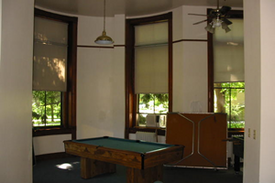Sorin Hall is a dormitory on the campus of the University of Notre Dame, where John Bellairs lived during both his junior (1957-58) and senior (1958-59) years.
History[]
Sorin Hall, also known as Sorin College, is the oldest of the Residence Halls on the campus, and located directly south of the Basilica of the Sacred Heart. Its distinctive turret rooms on the four corners as well as its pure nobility distinguish it from all other campus buildings. Sorin Hall is, along with other building on the Main Quad of Notre Dame, on the National Register of Historic Places. The structure as it exists today was completed in 1897 with the addition of two wings and, later in 1905, its iconic front porch. During the Vietnam War, the men who resided there broke away from the university, holding classes in the dorm and boycotting university events. A wooden sign above the porch, declaring the dorm "Sorin College" remains[1].
Bellairs In Residence[]

A contemporary view of Bellairs's corner room, after remodeling.
Bellairs lived by himself in room 119 for the 1957-58 school year and when the dormitory was classified for juniors. Sorin was built at a time when high ceilings were in style and Bellairs occupied such a room, a splendid high-ceiling corner turret room in the southeast corner on the first floor. The Scholastic reported these rooms as "large enough to encourage study, and at the same time small enough to discourage visiting[2]." A few years later in his own debut Scholastic article ("the beginning: a little too much about the author"), Bellairs identifies the hall as "South Bend's answer to the House of Usher" and notes that:
My room is at least 15 feet high, its exact height being a mystery because of the everpresent cloud formations, and is decorated to resemble a cross between a Victorian tenement and a Pompeian attic.
The following school year (1958-59), Bellairs benefited from the dormitory's reclassification from a junior to a senior hall and triumphantly held on to his highly treasured room - "perfect for the bull sessions that are such an indispensable feature of college life.[3]" Other students remember how that high-ceiling room "always seemed busy with people stopping in and out to chat.[4]"
Bellairs kept his room pretty cloudy with pipe smoke: "He was especially fond of a big calabash of the kind traditionally associated with Sherlock Holmes. When he went out he carried smaller pipes with him, but in his room he preferred the calabash.[5]" Myers notes this habit was abandoned in early adulthood[3].
"Also, the junk he collected in his room ran to Gothic (in the old sense) and grotesque kitsch - pipe racks with little carved faces and figures, beer mugs bearing sentimental verses in German (Trink was klär ist; lieb was rär ist), that sort of thing. Miniature cuspidors probably were included in the collection, though I don't remember them in particular.[5]"
While Bellairs chose a spacious first floor room, other seniors went underground to the basement, an area not originally scheduled for human habitation. These rooms, added some time after the hall was built, had ceilings of a more normal height.
"Why did some of the rest of us choose, or even scheme to get, the basement? Did living underground help us feel like an intellectual bohemian type? Or was it because the priest who was the rector lived on the first floor? He was reasonably permissive about things like drinking, but hiding underground gave extra security. It was understood he would never come down to the lower depths and poke around.[6]"
Gibson also notes that the verbal description of Prospero's house, and the frontispiece illustration of The Face in the Frost, reminds him of "weird old Sorin Hall, compact and cubical, with its two round pointy towers - definitely our fustiest campus residence.[6]"
There were three or four rooms between the main entrance and the turret room where Bellairs lived. These rooms appear to have been merged to create a student lounge following massive hall renovations during the 1980s.
Gallery[]
Reference[]
- ↑ Wikipedia: Sorin Hall
- ↑ "Sorin - Hall of Tradition", Harry Niemann; Notre Dame Scholastic, Vol. 96, No. 6 -- November 12, 1954.
- ↑ 3.0 3.1 Correspondence with Alfred Myers.
- ↑ Correspondence with Robert Sedlack.
- ↑ 5.0 5.1 Correspondence with Charles Bowen.
- ↑ 6.0 6.1 Correspondence with Phillips Gibson.

